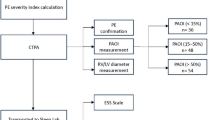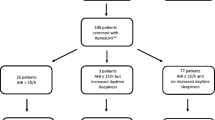Abstract
Background
Obstructive sleep apnea (OSA) might be an independent risk factor for acute pulmonary embolism (APE).
Aim of the study
A prospective cohort study was conducted to investigate if APE is sleep-related in untreated OSA syndrome or not.
Methods
206 APE patients were evaluated by portable monitoring and polysomnography. APE symptoms which caused an arousal from sleep or occurred within the first hour after wake-up were considered to be sleep-related.
Results
APE manifestation is significantly more often sleep-related in patients with moderate or severe OSA compared to subjects with an apnea–hypopnea index ≤15/h (p < 0.001). The relative risk of sleep-related APE increases with the severity of OSA.
Conclusions
OSA might trigger APE, possibly reflecting a pathophysiological relationship between these two conditions.



Similar content being viewed by others
References
Caples SM, Gami AS, Somers VK (2005) Obstructive sleep apnea. Ann Intern Med 142(3):187–197
Lippi G, Mattiuzzi C, Franchini M (2015) Sleep apnea and venous thromboembolism. A systematic review. Thromb Haemost 114(5):958–963
Toraldo DM, De Benedetto M, Scoditti E, De Nuccio F (2015) Obstructive sleep apnea syndrome: coagulation anomalies and treatment with continuous positive airway pressure. Sleep Breath. doi:10.1007/s11325-015-1227-6
Linz D, Woehrle H, Bitter T, Fox H, Cowie MR, Böhm M, Oldenburg O (2015) The importance of sleep-disordered breathing in cardiovascular disease. Clin Res Cardiol. 104(9):705–718
Arzt M, Luigart R, Schum C, Lüthje L, Stein A, Koper I, Hecker C, Dumitrascu R, Schulz R, “Circulation and Sleep” working group of the German Society of Sleep Research and Sleep Medicine (DGSM) (2012) Sleep-disordered breathing in deep vein thrombosis and acute pulmonary embolism. Eur Respir J 40(4):919–924
Stein PD, Saltzman HA, Weg JG (1991) Clinical characteristics of patients with acute pulmonary embolism. Am J Cardiol 68(17):1723–1724
Berghaus TM, Faul C, von Scheidt W, Schwaiblmair M (2015) The prevalence of sleep-disordered breathing among survivors of acute pulmonary embolism. Sleep Breath. doi:10.1007/s11325-015-1209-8
Johns MW (1993) Daytime sleepiness, snoring, and obstructive sleep apnea. The Epworth Sleepiness Scale. Chest 103(1):30–36
Konstantinides SV, Torbicki A (2014) Management of pulmonary embolism: recent evidence and the new European guidelines. Eur Respir J 44(6):1385–1390
Jiménez D, Aujesky D, Moores L, Gómez V, Lobo JL, Uresandi F, Otero R, Monreal M, Muriel A, Yusen RD (2010) Simplification of the Pulmonary Embolism Severity Index for prognostication in patients with acute symptomatic pulmonary embolism. Arch Intern Med 170(15):1383–1389
Anderson FA Jr, Spencer FA (2003) Risk factors for venous thromboembolism. Circulation 107(23):9–16
Erman MK, Stewart D, Einhorn D, Gordon N, Casal E (2007) Validation of the ApneaLink for the screening of sleep apnea: a novel and simple single-channel recording device. J Clin Sleep Med 3(4):387–392
American Academy of Sleep Medicine. The AASM manual for scoring of sleep and associated events: rules, terminology and technical specifications 2012, Version 2.1., Westchester
Berro LF, Andersen ML, Tufik S (2015) Prevalence and classification of sleep-disordered breathing. Lancet 3(4):263–264
Berghaus TM, Faul C, Unterer F, Thilo C, von Scheidt W, Schwaiblmair M (2012) Acute pulmonary embolism in patients with obstructive sleep apnoea: does it affect the severity of sleep-disordered breathing? Sleep Breath 16(4):1267–1269
Bokinsky G, Miller M, Ault K, Husband P, Mitchell J (1995) Spontaneous platelet activation and aggregation during obstructive sleep apnea and its response to therapy with nasal continuous positive airway pressure. A preliminary investigation. Chest 108(3):625–630
von Känel R, Natarajan L, Ancoli-Israel S, Mills PJ, Wolfson T, Gamst AC, Loredo JS, Dimsdale JE (2013) Effect of continuous positive airway pressure on day/night rhythm of prothrombotic markers in obstructive sleep apnea. Sleep Med 14(1):58–65
Shamsuzzaman A, Amin RS, Calvin AD, Davison D, Somers VK (2014) Severity of obstructive sleep apnea is associated with elevated plasma fibrinogen in otherwise healthy patients. Sleep Breath 18(4):761–766
Hui DS, Ko FW, Fok JP, Chan MC, Li TS, Tomlinson B, Cheng G (2004) The effects of nasal continuous positive airway pressure on platelet activation in obstructive sleep apnea syndrome. Chest 125(5):1768–1775
Phillips CL, McEwen BJ, Morel-Kopp MC, Yee BJ, Sullivan DR, Ward CM, Tofler GH, Grunstein RR (2012) Effects of continuous positive airway pressure on coagulability in obstructive sleep apnoea: a randomised, placebo-controlled crossover study. Thorax 67(7):639–644
Toukh M, Pereira EJ, Falcon BJ, Liak C, Lerner M, Hopman WM, Iscoe S, Fitzpatrick MF, Othman M (2012) CPAP reduces hypercoagulability, as assessed by thromboelastography, in severe obstructive sleep apnoea. Respir Physiol Neurobiol 183(3):218–223
DGSM (2012) S3-Leitlinie unerholsamer Schlaf/Schlafstoerungen [S3 guideline for unrestorative sleep/sleep disturbances] Somnologie 13:4–160
Dolliner P, Brammen L, Graf S, Huelsmann M, Stiebellehner L, Gleiss A, Ubl P, Steurer G (2013) Portable recording for detecting sleep disorder breathing in patients under the care of a heart failure clinic. Clin Res Cardiol. 102(7):535–542
Author information
Authors and Affiliations
Corresponding author
Ethics declarations
Ethical standards
The study was conducted with the approval of the Ethics Committee at the Ludwig-Maximilians University Munich (080-11). All study participants gave informed consent.
Conflict of interest
The authors declare that they have no conflict of interest.
Rights and permissions
About this article
Cite this article
Berghaus, T.M., Witkowska, A., Wagner, T. et al. Obstructive sleep apnea might trigger acute pulmonary embolism: results from a cohort study. Clin Res Cardiol 105, 938–943 (2016). https://doi.org/10.1007/s00392-016-1002-0
Received:
Accepted:
Published:
Issue Date:
DOI: https://doi.org/10.1007/s00392-016-1002-0




